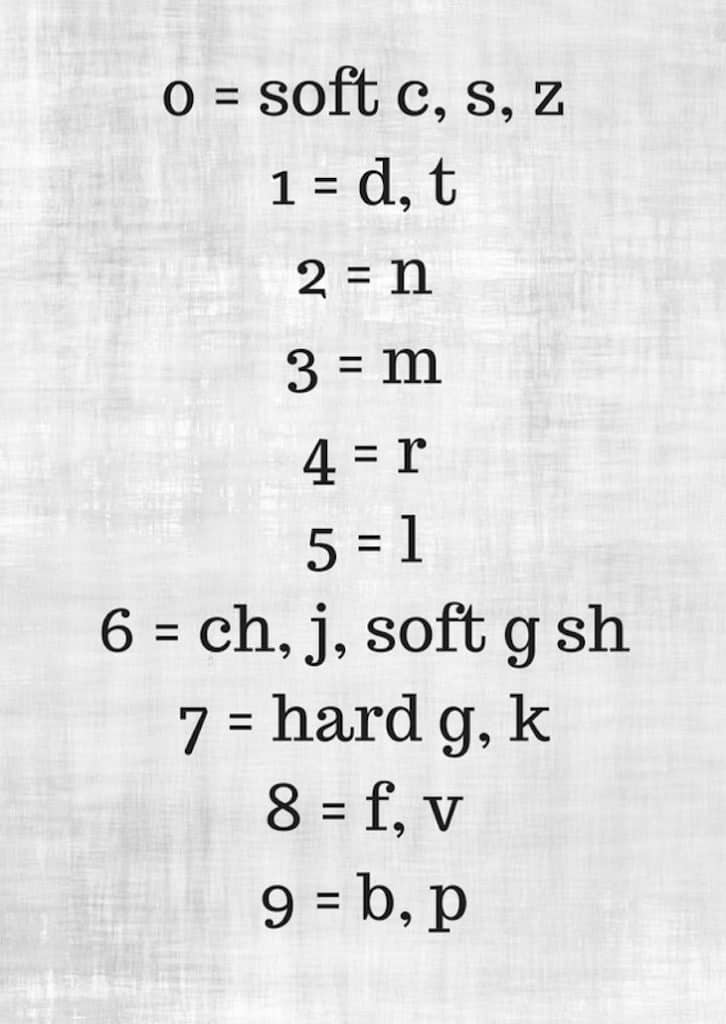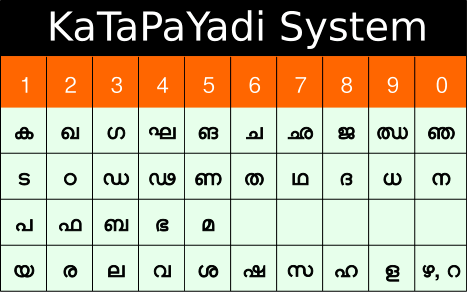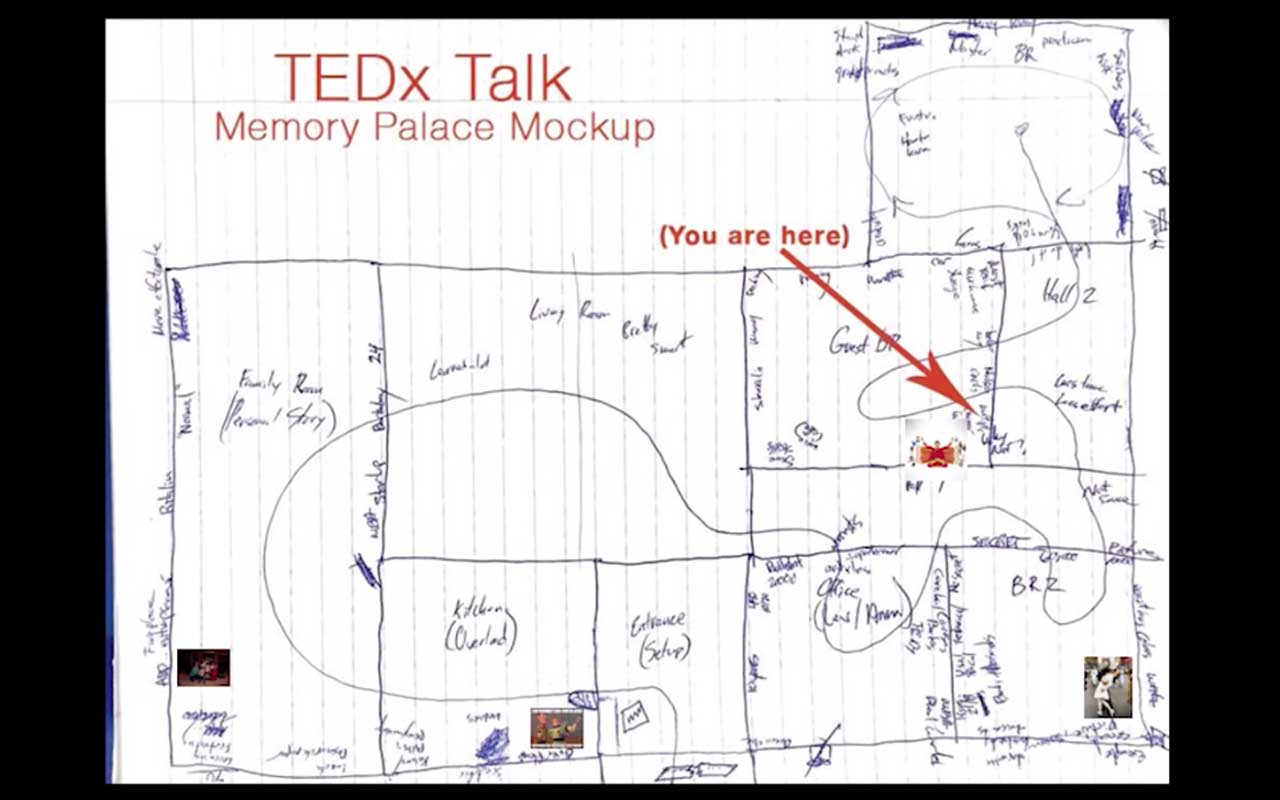 If you’re seeking memory training due to forgetfulness, or you’re just tired of struggling with information overload, you’re not alone.
If you’re seeking memory training due to forgetfulness, or you’re just tired of struggling with information overload, you’re not alone.
Not only have I been there. I’ve spend decades practicing a variety of memory systems and enjoying substantial results.
Thanks to the success of my work on this website, I’ve also been helping others do the same.
All based on how how I used the ancient art of mnemonics to pass my PhD at York University, learn languages and deliver one of the most-viewed TEDx Talks on the topic of memory.
I don’t share these accomplishments to brag.
Rather, it’s to show you that memory training is not a gimmick.
It’s a timeless art and science that anyone can master. I’ve been teaching people around the world exactly how to recall large amounts of information for more than fifteen years.
And now I’m going to show you how you can do the same.
The trick to it all is that you have techniques to train with. The comprehensive list of techniques on this page gives you the best training tools in existence and shows you examples of how to use them.
Ready?
Let’s dive in!
Proof that Memory Training Works
As we go through the list of memory techniques you can start practicing with today, keep in mind that there’s no particular order of importance.
They all matter and each one is well-worth spending time learning.
But you might like to have some assurance that scientists have actually studied these memory tools.
In addition to reading my full profile of the state of memory science, you’ll be delighted to know that many of my memory champion friends have participated in memory studies.
For example, Katie Kermode recently posted on LinkedIn about her participation in this University of Cambridge Study.
This study follows many others, including a major analysis of how proper memory training leads to superior memory skills.
I’ll share a few more scientific references as we go, but for now, keep in mind that we are talking about training.
This means that your time does need to be spent on learning and applying the various memory techniques we’re about to explore together.
But every moment will be worth it once you see the results of better memory flowing into your life.
One: Mnemonic Linking
Mnemonic linking is where most people start training their memory. It’s a simple technique where you create vivid, strange or emotional association between information you already know and something new you want to retain.
For example, let’s say you need to remember a list of words like “apple,” “book” and “dog.”
The linking technique suggests that you mentally link the apple with something specifically familiar to you. I would personally forge a link with an Apple computer.
For the next word in the list, I would imagine the Apple computer interacting with a specific book. Since the final word is “dog,” that book could be the Bible in the jaws of a specific dog.
The key is to make every association specific. So in this case, the list will be easiest to remember if there’s a kind of mnemonic story playing out:
“An Apple computer flies down from the sky to try and wrestle the family Bible from the jaw of Superman’s dog.”
Silly, right?
Yes, and that’s what makes it so memorable.
In case you’re interested, one of the reasons why so many people start with linking isn’t because it’s the best place to start.
It’s largely because that’s where the dominant memory improvement authors like Harry Lorayne and Tony Buzan talked about starting. They were largely repeating the instructions given by Bruno Furst in his correspondence memory courses.
Linking is definitely worth learning. I use it frequently and found it especially helpful for learning the articles and other aspects of learning German.
Two: Peg Systems
Peg systems are the foundation of how I learned to memorize playing cards.
Please be aware that memory teachers use the general term “peg” in quite a variety of ways.
I generally call it the pegword method and separate pegs into at least four different kinds of mnemonic images:
- Number Rhymes
- Number objects (or number shapes)
- Major System
- PAO System
To give you an example of the simplest peg system, here’s how the number rhyme technique works through the association of rhymed images:
Once you’re set up with these rhymes (or variations of your own choosing), associating information using this technique will be a breeze.
To give you an example, let’s refer back to our previous list.
Using number rhyme pegs, you could imagine the apple growing as large and as bright as the sun. The book could be shaped like a shoe, and smell just as bad. And the dog could be chasing bees.
The advantage to number rhymes is that you not only remember the items. You also remember the numbered order of each item in the list.
Another advantage when you develop your skills will all four peg systems is that you have pre-learned mental associations.
You don’t have to invent new links on the fly. You have mental “pegs” to hang new information on.
Please train with all of these peg systems in the bulleted list above because having multiple tactics offers tremendous flexibility when you want to remember things quickly.
Three: Keyword Mnemonics
When preparing for my TEDx Talk, I didn’t memorize every word.
Instead, I pulled out only the most important words. This is generally the best approach to to memorizing a speech.
By compressing the speech into a smaller set of memory triggers laid out along a Memory Palace journey, I was able to convey the main points without having to memorize the entire speech verbatim.
As a result, you can memorize two or three words and still recall entire sentences.
For example, my TEDx begins with the line, “How would you like to completely silence your mind?”
The images are simple Howie Mandel with a stick of wood hitting a like button on a YouTube video. Since I know the topic of my talk, I didn’t need to encode the rest of the phrase.
Verbatim Memorization By Making Every Word a Keyword
Now, if you’ve seen my TEDx Talk, you might have noticed that I recite a few quotes and Sanskrit phrases.
This is verbatim memorization, but it’s essentially the same process.
Instead of extracting keywords, every word is memorized as if it were a keyword. To practice this, I suggest you complete my tutorial on how to commit poetry to memory.
As an additional resource, please consult my detailed tutorial on how to memorize a paragraph.
Four: Alphanumeric Mnemonics
I mentioned the Major System above.
Let’s dig deeper into how this technique works so you can easily remember important phone numbers, credit cards, historical dates and even matters related to programming on demand.
What is it?
The Major System is called an “alphanumeric” technique because it helps you transform numbers into consonant sounds.
You then turn these into memorable words by inserting vowels between the consonants.
The Major System is a foundational technique and merely learning to use it will provide you with outstanding memory training.
Here’s the exact alphanumeric pattern I’ve used for decades:

Once you’ve committed this set of associations to memory, here’s how it works:
If you have to memorize the number 34, you note that 3 = M and 4 = R.
You then insert a vowel and come up with a word like “mare” or a person like “Mary.”
Personally, I use “mare” as my word for 34, but make it more specific by thinking of a specific horse: the one pictured on the cover of Piers Anthony’s Xanth novel, Nightmare.
Although this technique is primarily used for remembering numbers, you can actually use it to remember many other things.
For example, often when I learn new words in different languages, I observe the consonants and work out what numbers they would be in the Major System.
This makes it fast and easy to come up with associations.
For example, in German, “blacksmith” is der Schmeid.
In the major, the “sch” sound can be represented by 6, which also covers J sounds. D is linked with 1.
61 makes words like “Jedi” and Judd. So I can imagine the actor Judd Nelson “smushing” his Jedi uniform into a suitcase shaped like an E.
Although that’s not 100% direct, it doesn’t have to be. With a small amount of spaced repetition, the target information will enter long-term memory.
A Brief History of Alphanumeric Mnemonics
Although it can be a bit tough to learn in the beginning, rest assured that people have been using mnemonic tools like the Major System for thousands of years.
For more background, check out Lynne Kelly’s The Memory Code.
In my own research, I’ve found the katapayadi system, which goes back to at least 869 CE.
I find the length of time this particular type of tool for establishing memories has been around inspiring. Hopefully it will continue to survive for both practical uses and fun projects like memorizing pi.
Five: The First Letter Mnemonic Technique
This next technique is great for training with poetry, song lyrics and quotes.
To use it, all you do is take the first letter of each word and write it on a piece of paper.
Here’s what I mean using the opening of Shakespeare’s Sonnet 59:
“If there be nothing new, but that which is hath been before…”
Once you’ve written out the letters, you look at the list and practice recalling all the words in full.
It is literally an exercise in mentally filling in the blanks.
As a learning technique, this approach is related to the Cloze test. In this laboratory study of using what the scientists called the “first Initial mnemonic,” students who used it as part of their studies showed significantly better recall.
Although I would never use this approach to memorize something mission critical like a speech, it is a good training exercise. I use it a couple of times a year just for practice.
Six: Story-Telling For Better Memory
I mentioned the power of crafting mnemonic stories above. Let’s go deeper.
As we know from the story of Simonides of Ceos, the brain loves stories because it finds them instantly memorable.
That’s one reason why the Renaissance memory master Robert Fludd talked about using theatre plays in your associations.
I personally use this approach often, and have a full Story Method tutorial that will help you use it in a highly targeted way for both training your memory and as a learning tool.
Seven: The Memory Palace Technique (The Gold Standard)
The Memory Palace technique changed my life.
Also known as the method of loci, it’s powerful because it lets you use one of our most powerful types of memory and mental faculties:
Spatial memory.
In other words, you place associations paired with your target information along a familiar route or location in your imagination.
Then, using spaced repetition and one of the association techniques discussed above, you revisit the images you placed along the journey. Soon, you’ll have the information you want to remember in long-term memory.
That’s exactly what I did to memorize my TEDx Talk using keywords after making a quick sketch of a familiar location:
And like all memory techniques, the Memory Palace has been thoroughly vetted by researchers.
According to a Nature article prepared by Eleanor Maguire and her team, anyone can reshape their brain’s networks by using this technique.
As the scientist’s revealed when sharing the brain scans of memory champions who use the technique, their success in remembering vast amounts of information quickly came from using this spatial memory technique.
The researchers then put non-memory athletes through a memory training program and observed how their brains changed with exercise.
The more the newcomers practiced the memory training techniques, the more their brain activity started to resemble the brains of memory athletes.
That means you can expect similar memory boosts, even if you’re a beginner with this particular mnemonic device.
Beyond Training with Techniques: Daily Memory Exercises
Developing stronger memory skills is generally best approached using the techniques I just shared with you.
However, there are other smaller actions you can take to create remarkable results over time.
Here are some recommended daily memory-boosting exercises I personally use and recommend:
One: Brain Games and Puzzles
You can stimulate multiple aspects of your cognition by playing a variety of brain games.
In addition to the classics like Sudoko and matching games, you can get involved with my Memory Detective game. We usually play a round every Halloween in the Magnetic Memory Method community.
Two: Regular Mindfulness and Meditation
Even just ten minutes a day of sitting meditation can improve your focus and working memory.
As this study shows, less is definitely more.
Not only did they find that brand-new meditators enjoyed better memory. They also experience mood boosts and greater levels of emotional regulation.
Three: Physical Exercise for Brain Health
Although I don’t always feel like it, I work hard to get myself to the gym three times a week. Or I will do a calisthenic routine at home.
I also take walks almost every day, including walking backwards. As this study showed, even just imagining that you’re walking backwards produced a memory boosting effect.
Personally, I prefer the real thing, even though it gets strange glances when I do it at the local outdoor gym.
Four: Learn Something New Every Day
Whether it’s studying a new language, a musical instrument or practicing a hobby like writing, continually learning new topics and skills keeps your brain engaged.
It also helps with neuroplastic change, literally rewiring your brain for better processing speed and memory.
You might also consider exploring a variety of ways to learn. If you typically take notes in a top-down fashion, for example, you can spend a few months on Tony-Buzan style mind mapping for a change.
Final Thoughts: You Don’t Need a “Photographic Memory”
Many people ask me to teach them to have a photographic memory.
I always turn them down because most of what we need to memorize is in language, not pictures.
Plus, photographic memory is widely considered to be pseudoscience.
Ultimately, if you want a trained memory, or even just to learn faster, every technique you’ve discovered on this page is very learnable.
If you’d like more help, especially with the Memory Palace technique, please complete my free course:
It will gives you the ultimate memory improvement exercise by focusing on spatial memory through four free videos and three powerful worksheets.
And if you’d like more information on additional mnemonic tools, this list of memory techniques goes deeper.
The important point is to get started and keep going.
The absolute best years of your learning and remembering life await!
Related Posts
- Memory Strategies: 9 Shockingly Easy Ways to Improve Your Memory
What are memory strategies and how do they work? Can they help you achieve your…
- 3 Blazing Fast Ways To Increase Memory Retention
Memory retention... what the heck is it? Is it worth worrying about? If so, can…











22 Responses
I’m loving this topic, Anthony. It’s so very interesting to hear about what different countries are doing with memory techniques. The Mongolian school is the most fascinating and inspiring. I would love to see that idea in Australian schools. I’m looking forward to listening to the next episode (out today, I see)! Thanks!
Thanks kindly, Avril. It’s great hearing from you.
In part two, we discussed Australia, which you’ve noted is already out.
In case you’re not aware, Lynne Kelly has been doing a lot for Australian schools as well. You can hear our discussion about it and her book The Memory Code if you haven’t already given it a list.
One way to help ensure that Australian schools get more of this information is to support her work, so I hope you can get a copy of The Memory Code and learn more about what she’s doing. The more of us who get on board and active, the more the change we want to see in the world can actually take place.
Thanks for taking a moment to comment and I look forward to your next post. Every short sentence of support helps! 🙂
Appreciation for the Code of Memory
Thanks, Tamiau. I appreciate it.
Are you currently training your memory for any small or large scale learning projects? Do you have any questions about the journey?
Seriously wanting to know more
That’s great, Tamiau. Please consider registering for my free course. I think you’ll find it very useful and look forward to seeing your homework.
Very interesting content! And thanks for the free lessons!
My pleasure, Shan. Thanks for stopping by.
How will you implement the memory improvement ideas you’ve learned?
Is there an in person course I could take? I have gotten more than halfway through the superlearner course and don’t think I am going to get the results I hoped for. I would really like to take a class that is not online. If you don’t offer one do you know of a place that might?
Thanks kindly for asking about this, Jamal.
I’m sure there are in-person trainings you can take in your community. Where in the world are you?
Through the magic of the Internet, I’m also able to help people in real time, either through one-on-one training or group training. In September, for example, we held a live online training called “Study Hacks.” I might do it again before the end of the year, or something similar.
What are the results you’re looking for and what have you done until now to implement what you’ve been learning thus far?
Beginning to see the change on first day. Great technique
So glad to hear that the results are kicking in. The more you practice, the better it gets. Keep going and let us know how we can help along the way. 🙂
Anthony
Can you tell us how numerical and photonic codes are used in the Alpha Numeric Spectrum system to help us memorize and recall numbers with ease.
I’d need to see an example of exactly what you want to memorize.
If it involves memorizing letters with numbers, you’ll want to develop an Alphabetical List of Images for yourself (ALI).
I want to memorize random numbers and I have made a ‘new’ system which is similar to the Major System for memorising random numbers, However almost half of the time it is giving me meaningless words,
And I believe that using colors instead of the letters which are making my words meaningless Will help me make my system easier to use as I have been advised to make my system easy to learn and apply, fun to use and fast.
And while my system is fast and easy to learn it is not easy to apply and I think that using colors instead of numbers will help me a lot in making my system easy to apply so that I can make my system a massive success (by making it “Easy to learn, easy to apply and fun”) and these words were told to me by a great man.
Cheers.
Dave Farrow talks about using colors to remember numbers. Have you heard my podcast interview with him?
Yes, I had heard your podcast interview with him.
Great! Please enjoy! 🙂
I need help in recalling algorithms.
if odd number move right
if even number move left
Please say more, Aarjay.
What kind of algorithm requires you to memorize rules based on odd or even numbers?
I have spent a lot of time watching your videos and reading about the techniques, but I continually struggle with the same problems that I just can’t seem to figure out. A little back story, I am a adult student that returned to school 20 plus years after high school and changing career fields. I have gone through the diploma course and graduated, but here is where my problem lays.
My new career field is in information technology, and there are so many courses and things to learn but they all relate one way or another to a different course. Meaning that a term or topic may be in multiple different courses, each time either just showing the term or elaborating upon it. Which is problem number 1, how to deal with things that are not a one and done, again seeing it many time in different courses.
The second problem I am struggling with is the size of the mind palace. There are so many points, terms, coding lines, and just general order of things that to count out beforehand is just not feasible, so how to I organize which palaces to use that won’t be to small or that I won’t only use a partial palace, essentially wasting half of something I could use?
I am now getting myself ready to study for certifications in many fields like hardware, software and in cybersecurity which is where I am aiming to go. Getting myself organized and confident is what I really need to do, so any help would be greatly appreciated.
Thanks for this, Richard.
First, a question:
Are you just watching the videos, or watching them and taking action?
Many people struggle to “figure it out” without actually following the steps. That is a very hard and unnecessarily long path to follow.
The teaching here is very simple for those who follow the steps:
Create and use a minimum of 26 Memory Palaces to start getting the hang of things and expand your spatial memory so the other levels of memory can also expand.
Having a topic appear in multiple courses is a non-issue for people using this technique because the Memory Palace is not for storage. It is a device used to help speed the transfer of information into long term memory. If you’re not using it correctly, this won’t happen. When you do use it correctly, long term storage is inevitable.
With respect to size, one should worry about big Memory Palaces after having mastered the small. If you follow the steps that I am teaching by starting with approximately ten stations per Memory Palace, you’ll be able to scale to many different sizes of Memory Palaces and scale vast networks to help you accomodate nearly any volume of information related to the actual necessity on hand (which many learners unfortunately exaggerate when they are trapped in a scarcity mindset).
Without mastering the fundamentals first, it is highly unlikely that people will proceed to an intermediate or advanced level.
Does this way of looking at things help you out?